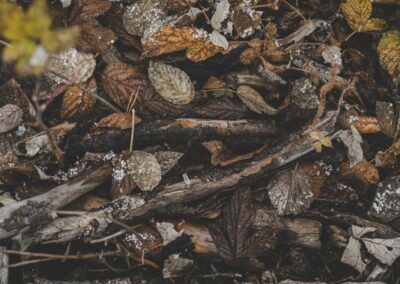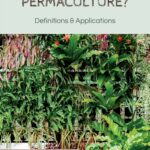Permaculture isn’t so easy to define precisely — many of the methods and ideas used are not necessarily original, but have been assembled in the framework of permaculture.
Definitions of Permaculture
Introduction to Permaculture
According to the Cambridge Dictionary, permaculture is “systems for growing crops, plants, etc. that cause little damage to the environment and can therefore continue for a long time. Permaculture aims to develop a landscape that will be self-sustaining and productive for generations. A permaculture garden can be as small as a balcony or many hectares in size.”
According to Wikipedia (and like it or not, this definition may be more accurate – or at least more complete), permaculture is “a set of design principles centered on whole systems thinking, simulating, or directly utilizing the patterns and resilient features observed in natural ecosystems. It uses these principles in a growing number of fields from regenerative agriculture, rewilding, and community resilience.”
I would choose to define permaculture as a set of design principles aimed at working with nature (rather than against nature), as well as supporting or mimicking patterns and features found in nature to as closely as possible.
Permaculture can encompass any aspect of life.
One of the founding fathers and practitioners, Bill Mollison actually coined the term “permaculture”. Mollison was an Australian researcher who taught at the University of Tasmania. His book is still the standard for anyone wanting to learn the theories and concepts of in-depth permaculture.
The 12 Principles of Permaculture
Permaculture is founded upon 12 main principles — ethical propositions that permaculturists return and refer to at every step, and with each element of their designs.
Read more about it here: https://permacultureprinciples.com/principles/
Applications of Permaculture
The Use of Permaculture to Plan and Landscape a Property
Permaculture helps us design a property to collect water, grow food (and other plants) and provide an optimized living environment for people, as well as for animals (both domesticated and wildlife).
This process starts with “permaculture zoning:” a process aimed at separating the property into different zones, starting from zone 0 (the main residence) and moving outward to reach zone 5 (nature).
Growing Food with Permaculture
Permaculture helps us grow food by implementing its applications in gardening, creating food forests (also known as agroforestry) and farming plots. Growing food with permaculture includes many widely spread techniques such as:
- No-till gardening
- Companion planting: using plants to support other plants, so we can reduce the use of pesticides and fertilizers
- Digging swales to collect and retain water, so less water is spent on irrigation
- Using local and heritage varieties of fruit and vegetable, as well as saving seeds.
Keeping Permaculture Animals
In permaculture, it’s important to have all elements of your property working together. This means that animals have an integral role in keeping the cogwheels turning. Each animal will usually have different functions. For instance, a small herd of alpacas might be used for:
- Grazing and cleaning brushes on the property
- Producing high-quality manure
- Soft fleece after shearing
- Guarding chickens from foxes.
Most animals (if not all) will contribute in varying ways to a well-rounded permaculture approach to your farm.
Urban Permaculture
Permaculture and variations of it are readily applied to urban situations, both on small and larger scales:
- To repurpose old buildings and build new structures to be multifunctional
- To increase both urban and guerilla gardening — gardeners growing food and useful plants in all corners and nooks of cities and towns (even without having legal rights to do so, in the case of guerilla gardening)
- By applying permaculture in community gardens, backyards and even window sills, people can grow more food in small spaces.
Regreening the Desert with Permaculture
Permaculture techniques often are applied to turn desertified, depleted fields or areas into lush environments, producing an abundance of food.
A beautiful example of this is the rebuilding of the Loess plateau, a process orchestrated and put on film by the amazing John D. Liu. Watch a short overview below, or watch the full video on YouTube – click here.
The Difference Between Permaculture and Organic Gardening
Although permaculture always implies the use of organic methods, permaculture goes further than just that.
Organic gardening (or organic farming) does not exclude the use of less-than-desirable techniques, like monoculture, the housing of production animals in small cages in big facilities, destroying wildlife, etc.
Is Permaculture Sustainable at a Larger Scale?
The application of permaculture on a larger scale does require a major change in mindset, one that must be implemented by all involved. These action initiatives might include:
- Creating more community gardens in urban areas.
- More people growing some food themselves — on window sills, in their backyards, on their roofs, etc.
- People eating less meat. In this era, the overconsumption of meat has reached a level at which it’s almost impossible to incorporate all meat animals in existing ecosystems.
- Stepping away from monoculture — applying permaculture to restore depleted fields and regreen the desert, while using agroforestry to grow more food.
- Emphasising the importance of consuming local, seasonal fruits and vegetables.
- Creating systems to replace processed foods with natural alternatives.
- Reduce the production of crops that humans don’t actually need — and that are harder to produce without intensive monoculture (like corn or cereal).
Nowadays, permaculture most often is applied on a smaller scale — by people living off-grid, homesteading or trying to reduce their carbon footprint wherever they are.





















0 Comments